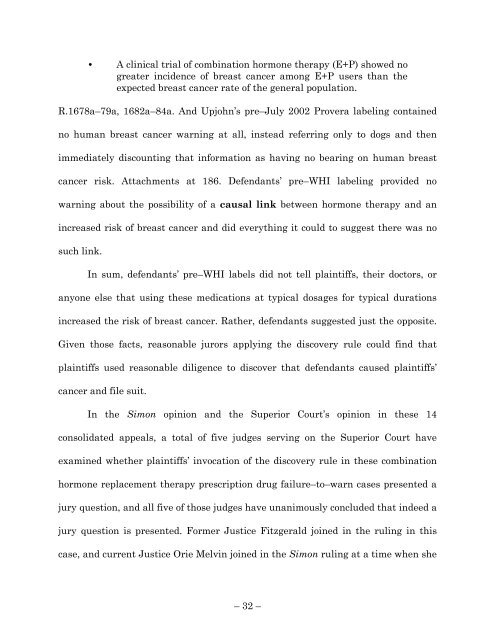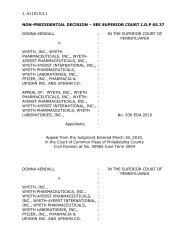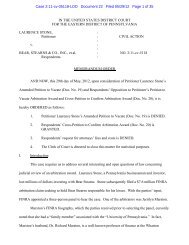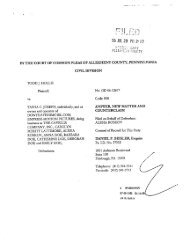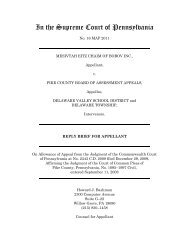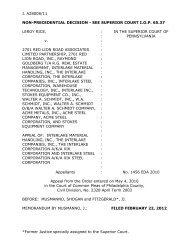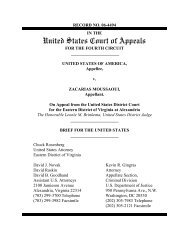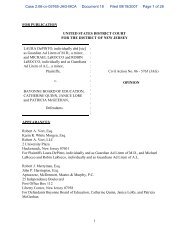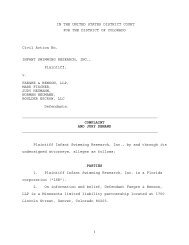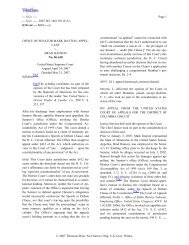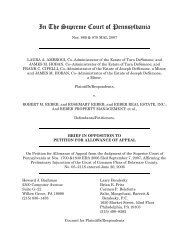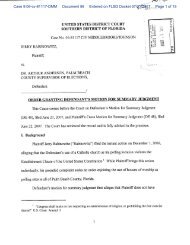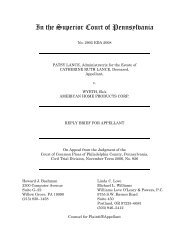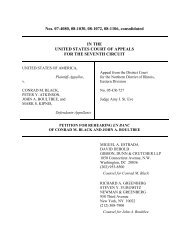In the Superior Court of Pennsylvania - How Appealing
In the Superior Court of Pennsylvania - How Appealing
In the Superior Court of Pennsylvania - How Appealing
Create successful ePaper yourself
Turn your PDF publications into a flip-book with our unique Google optimized e-Paper software.
• A clinical trial <strong>of</strong> combination hormone <strong>the</strong>rapy (E+P) showed no<br />
greater incidence <strong>of</strong> breast cancer among E+P users than <strong>the</strong><br />
expected breast cancer rate <strong>of</strong> <strong>the</strong> general population.<br />
R.1678a–79a, 1682a–84a. And Upjohn’s pre–July 2002 Provera labeling contained<br />
no human breast cancer warning at all, instead referring only to dogs and <strong>the</strong>n<br />
immediately discounting that information as having no bearing on human breast<br />
cancer risk. Attachments at 186. Defendants’ pre–WHI labeling provided no<br />
warning about <strong>the</strong> possibility <strong>of</strong> a causal link between hormone <strong>the</strong>rapy and an<br />
increased risk <strong>of</strong> breast cancer and did everything it could to suggest <strong>the</strong>re was no<br />
such link.<br />
<strong>In</strong> sum, defendants’ pre–WHI labels did not tell plaintiffs, <strong>the</strong>ir doctors, or<br />
anyone else that using <strong>the</strong>se medications at typical dosages for typical durations<br />
increased <strong>the</strong> risk <strong>of</strong> breast cancer. Ra<strong>the</strong>r, defendants suggested just <strong>the</strong> opposite.<br />
Given those facts, reasonable jurors applying <strong>the</strong> discovery rule could find that<br />
plaintiffs used reasonable diligence to discover that defendants caused plaintiffs’<br />
cancer and file suit.<br />
<strong>In</strong> <strong>the</strong> Simon opinion and <strong>the</strong> <strong>Superior</strong> <strong>Court</strong>’s opinion in <strong>the</strong>se 14<br />
consolidated appeals, a total <strong>of</strong> five judges serving on <strong>the</strong> <strong>Superior</strong> <strong>Court</strong> have<br />
examined whe<strong>the</strong>r plaintiffs’ invocation <strong>of</strong> <strong>the</strong> discovery rule in <strong>the</strong>se combination<br />
hormone replacement <strong>the</strong>rapy prescription drug failure–to–warn cases presented a<br />
jury question, and all five <strong>of</strong> those judges have unanimously concluded that indeed a<br />
jury question is presented. Former Justice Fitzgerald joined in <strong>the</strong> ruling in this<br />
case, and current Justice Orie Melvin joined in <strong>the</strong> Simon ruling at a time when she<br />
– 32 –


